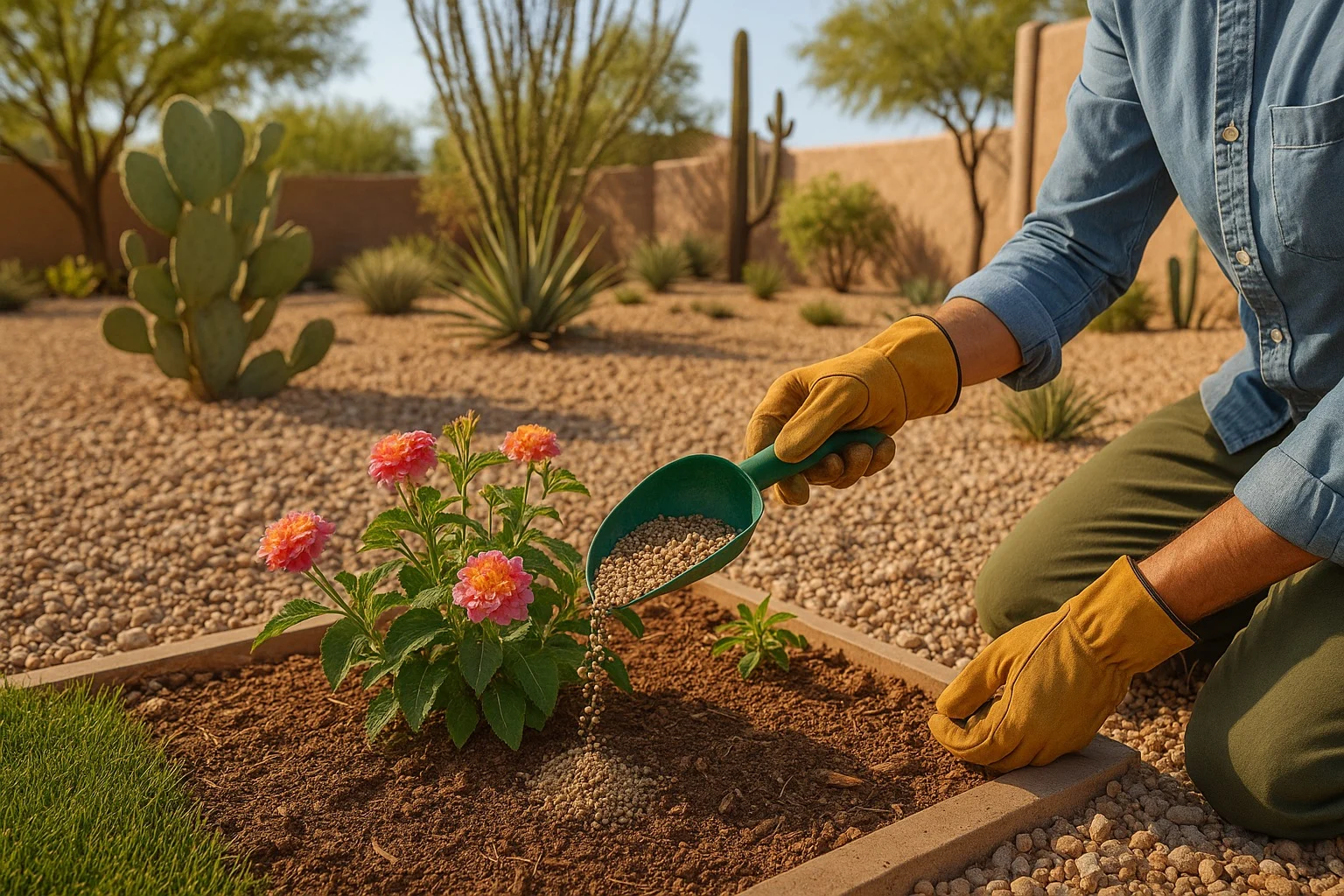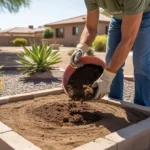Spring signals the perfect time for Mesa gardeners to jumpstart their yards and gardens, but misinformation about fertilization can lead to wasted effort or even damaged plants. As temperatures begin to climb in our desert region, understanding the truth behind common fertilization myths becomes crucial for achieving that lush, vibrant landscape you’re aiming for. Let’s separate fact from fiction and explore proven techniques that will boost your garden’s growth immediately this spring.

Understanding Mesa’s Unique Growing Conditions
Before diving into fertilization myths, it’s important to recognize what makes gardening in Mesa different from other parts of the country. Our alkaline soils, low organic matter content, and intense heat create a distinctive environment that requires specialized approaches to fertilization. Many nationwide gardening recommendations simply don’t apply here.
Mesa’s soil typically has a pH between 7.5 and 8.5, which is significantly more alkaline than the 6.0 to 7.0 range most plants prefer. This high pH can lock up certain nutrients, making them unavailable to plants even when present in the soil. Additionally, our low rainfall means that salts from irrigation water and fertilizers can build up over time, potentially causing plant stress or damage.
Our growing season also differs dramatically from cooler regions. While many parts of the country are just waking up from winter in early spring, Mesa gardens may already be in full growth mode by February or March. This extended growing season means our fertilization timing needs to be adjusted accordingly.
Myth #1: All Plants Need Heavy Fertilization in Spring
Perhaps the most pervasive myth is that all plants benefit from a heavy dose of fertilizer as soon as spring arrives. In Mesa, this one-size-fits-all approach can do more harm than good. Native desert plants like palo verde, mesquite, and many cacti have evolved to thrive in nutrient-poor soils and often require little to no supplemental fertilization. Overfertilizing these plants can trigger excessive, weak growth that’s more susceptible to pests and disease.
Even non-native ornamentals have varying fertilizer requirements. Roses and citrus trees, for example, are heavy feeders that benefit from regular fertilization, while many Mediterranean herbs prefer leaner soil conditions. Instead of blanket fertilization, take the time to research the specific needs of each plant type in your landscape. Group plants with similar fertilization requirements together to make maintenance more efficient.
For most established landscape plants in Mesa, a light application of a balanced, slow-release fertilizer in early spring is sufficient. New plantings may benefit from a starter fertilizer high in phosphorus to encourage root development, but follow up with a more balanced approach as they establish.
Myth #2: Synthetic Fertilizers Are Always Better Than Organic Options
Many gardeners believe that synthetic fertilizers, with their precise NPK (nitrogen, phosphorus, potassium) ratios, are superior to organic alternatives. While synthetic options do provide nutrients in forms immediately available to plants, they don’t address the long-term health of Mesa’s challenging soils. In our alkaline, low-organic matter environment, building soil health is just as important as feeding plants directly.
Organic fertilizers like compost, well-rotted manure, and bone meal work differently. They release nutrients more slowly as soil microorganisms break them down, which means less chance of nutrient runoff or salt buildup—both significant concerns in our desert environment. More importantly, organic materials improve soil structure, increase water retention, and enhance microbial activity, creating a healthier growing environment over time.
This doesn’t mean synthetic fertilizers have no place in Mesa gardens. They can be valuable for addressing specific deficiencies quickly or providing targeted nutrition during critical growth periods. The ideal approach often combines both: use organic amendments to build soil health gradually while supplementing with targeted synthetic fertilizers when needed for immediate results.
Myth #3: More Fertilizer Means Faster Growth
When spring arrives and we’re eager to see our gardens flourish, it’s tempting to apply extra fertilizer thinking it will speed up growth. This “more is better” approach can backfire dramatically in Mesa’s environment. Overfertilization can burn roots, create salt buildup in soil, pollute groundwater, and actually stunt plant growth rather than enhance it.
Excess nitrogen, in particular, can stimulate lush foliage at the expense of flowers and fruits. It can also make plants more attractive to pests like aphids and whiteflies, which thrive on the tender new growth. In Mesa’s hot climate, forcing rapid growth through heavy fertilization can leave plants vulnerable to heat stress as they struggle to support all that new foliage with limited water resources.
Instead of heavy applications, focus on consistent, appropriate feeding. For most established plants, applying fertilizer at half the recommended rate but twice as often provides steady nutrition without the risks of overfeeding. Slow-release formulations are particularly valuable in our climate, as they provide consistent nutrients over time rather than a single large dose that may leach away in our sandy soils.
Myth #4: Spring Is the Only Time to Fertilize
While spring is certainly an important time for fertilization, limiting your feeding schedule to this single season doesn’t maximize plant potential in Mesa’s extended growing season. Our unique climate means many plants continue active growth well into fall, and some even grow year-round with proper care. Developing a fertilization calendar that accounts for these extended growing periods can dramatically improve results.
For many landscape plants in Mesa, a three-part annual fertilization schedule works well: early spring (February-March), early summer (May-June), and fall (September-October). This approach provides nutrition during key growth periods while avoiding fertilization during the extreme heat of mid-summer when many plants are in survival mode rather than active growth. Citrus trees benefit from quarterly feeding, with the most important applications in February and September.
Winter-flowering plants like aloes and some native species may actually need fertilization in late fall or winter to support their blooming cycle. Understanding the specific growth patterns of your plants allows you to time fertilization for maximum benefit rather than adhering to the “spring only” approach that works better in colder climates.
Myth #5: Yellowing Leaves Always Indicate Nitrogen Deficiency
When leaves begin yellowing in spring, many Mesa gardeners immediately reach for high-nitrogen fertilizer. While nitrogen deficiency does cause yellowing (particularly in older leaves), this symptom can actually indicate numerous other issues that won’t be solved—and may be worsened—by adding nitrogen. In Mesa’s alkaline soils, yellowing leaves often signal iron chlorosis, a condition where plants cannot access iron due to high pH levels.
Water stress, salt buildup, pest infestations, and various nutrient deficiencies can all manifest as yellowing foliage. Before applying any fertilizer, take time to diagnose the specific issue. Look at which leaves are affected (new or old), the pattern of yellowing (all over or just between veins), and check for other symptoms like brown edges or spots.
For the common problem of iron chlorosis in Mesa, applying an iron supplement specifically formulated for alkaline soils will be far more effective than nitrogen. These products, often labeled as “iron for alkaline soils” or containing iron sulfate or chelated iron, can quickly restore the deep green color to affected plants. In severe cases, temporarily acidifying the soil around acid-loving plants with sulfur can help make micronutrients more available.
Effective Alternatives to Traditional Fertilization
Beyond conventional fertilizers, several alternative approaches can provide excellent results in Mesa gardens while addressing our specific growing challenges. Compost tea, made by steeping finished compost in water, delivers beneficial microorganisms along with gentle nutrition. These microbes can help break down organic matter, improve soil structure, and even suppress certain plant diseases—all valuable benefits in our challenging desert soils.
Mulching with organic materials serves a dual purpose in Mesa landscapes. Beyond conserving moisture and suppressing weeds, organic mulches gradually break down to add nutrients and organic matter to the soil. Materials like composted wood chips, shredded leaves, or even pine needles (for acid-loving plants) create a slow-release feeding system that improves soil health over time.
Cover cropping, though less common in home gardens, can be remarkably effective. Planting legumes like clover or vetch during the cooler months adds nitrogen to the soil naturally when the plants are turned under before they set seed. This approach not only adds nutrients but also improves soil structure and prevents erosion during our intense summer monsoon rains.
Smart Fertilization Techniques for Immediate Results
When quick results are needed, several targeted techniques can boost plant growth without falling prey to fertilization myths. Foliar feeding—spraying diluted fertilizer directly on plant leaves—allows plants to absorb nutrients immediately through their foliage. This approach is particularly effective for addressing micronutrient deficiencies like iron or zinc, which are common in Mesa’s alkaline soils. Apply foliar sprays in the early morning or evening to prevent leaf burn in our intense sun.
Deep root feeding can revitalize established trees and shrubs that show signs of stress or slow growth. This technique involves applying liquid fertilizer directly to the root zone, either through irrigation systems or by creating a series of small holes around the drip line and applying fertilizer solution. For Mesa’s valuable shade trees, this approach can provide dramatic results within a single growing season.
For vegetable gardens and annual flower beds, consider a combination approach: prepare beds with compost and organic matter before planting, then supplement with diluted liquid fertilizer during the growing season. This provides immediate nutrition while building long-term soil health. Water-soluble fertilizers with micronutrients specifically formulated for alkaline soils can be particularly effective for producing abundant harvests in Mesa’s challenging growing conditions.
Monitoring and Adjusting Your Fertilization Program
Perhaps the most important aspect of successful fertilization in Mesa gardens is ongoing observation and adjustment. Rather than following a rigid schedule, pay attention to plant responses and be willing to modify your approach. Look for signs of healthy growth like appropriate leaf color, strong stems, and abundant flowering or fruiting. Equally important, watch for indicators of problems like weak, leggy growth or leaf discoloration that might signal improper fertilization.
Soil testing provides valuable data for refining your fertilization strategy. While basic pH testing can be done at home with inexpensive kits, consider having a comprehensive soil analysis done every few years through the University of Arizona Cooperative Extension. These tests reveal not just nutrient levels but also soil texture, organic matter content, and salt levels—all critical factors for successful gardening in Mesa.
Remember that different areas of your landscape may have different needs. Newly planted areas, heavy feeders like vegetables and roses, and container plants will require more frequent attention than established native plantings. By creating a customized fertilization plan based on actual plant needs rather than general myths, you’ll achieve healthier, more resilient plants while conserving resources and protecting our unique desert environment.











